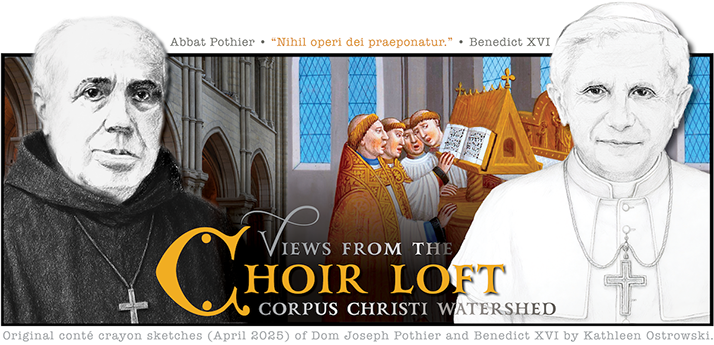 AST FRIDAY, I MENTIONED how the complete works of Palestrina can be downloaded in PDF format, but the clefs are archaic. I promised to show what can be done with these scores and today I fulfill my promise. They can quickly be placed into SIBELIUS, so the archaic clefs are eliminated. 1 Then your singers can more easily enjoy these treasures, many of which have not been sung for centuries! I want to talk about the NAME of this Mass, but first let’s explore:
AST FRIDAY, I MENTIONED how the complete works of Palestrina can be downloaded in PDF format, but the clefs are archaic. I promised to show what can be done with these scores and today I fulfill my promise. They can quickly be placed into SIBELIUS, so the archaic clefs are eliminated. 1 Then your singers can more easily enjoy these treasures, many of which have not been sung for centuries! I want to talk about the NAME of this Mass, but first let’s explore:
* * PDF Download • KYRIE “Te Saeculorum” (Palestrina)
Two generous young ladies—currently in high school—helped me record it:
MARVELOUS REHEARSAL VIDEOS for each individual voice have been created for volunteer choirs. To access them, locate #6995.

WHEN IT CAME TO CHOOSING a name for this Mass, Palestrina ran into a difficulty. There was not in Palestrina’s day—and amazingly still is not—a book which names the Gregorian hymn tunes. Because the text “Jam Christus astra ascenderat” used the melody, he chose that name. However, he could have easily chosen other names, which you can understand by reading the penultimate page of the score (SEE ABOVE). Throughout history, different melodies have been “married” to hymn texts—and this practice continues even now.
Indeed, Abbot Pothier chose different melodies in 1885 than he would twenty years later for the Editio Vaticana. For example, consider “Jesu Dulcis Memoria” and “Sanctorum Meritis” in this rare and fascinating book of hymns:
* * PDF • HYMNI DE TEMPORE ET DE SANCTIS (Pothier, 1885)
The choir I direct often sings a spellbinding polyphonic version of “Te Saeculorum Principem,” which is the same hymn melody Palestrina used for his Mass. That’s why I made this clear in the title of my edition, as well as marking the various points where the hymn tune occurs. But this Mass could just have easily been called the “Vexilla Christus” Mass; or the “Te Lucis” Mass; or the “Lucis Creator” Mass. 2 Indeed, it might well be called Missa Ad Coenam Agni. (Notice, by the way, the treatment of hypermetric syllables in that MSS.) Or, for that matter, Missa Lucis Creator. Or, looking at a hymnal from 1876AD, you could call it Missa Ad Coenam Agni—I give this as yet another example.
While there’s nothing incorrect about calling the Mass JAM CHRISTUS ASTRA ASCENDERAT, doing so might cause some to believe it’s for the Ascension. In fact, the hymn is suitable for Pentecost or the Sundays after Pentecost. If you read the literal translation by Fr. Joseph Connelly, you’ll agree it’s a really cool hymn. Notice where Connelly says, “The hymn stops abruptly, and some MSS tried to remedy this by adding another verse.”
If you think I’m getting worried over nothing, think again! For example, the wikipedia entry wrongly labels as this Mass as “for the Ascension” as you can see:
For the record, Fr. Haberl did something odd with the underlay in the “Christe” section of this KYRIE, inexplicably disrupting a pattern. I tried to “fix” it, but was not 100% successful. 3

I hope to transcribe and record more movements. Here is the SANCTUS.
MS D 9, folio 573 [283r] shows two Easter hymn texts with this tune:
![330 MS D 9 page 573 [283r]](https://i0.wp.com/archive.ccwatershed.org/media/photologue/photos/cache/330-MS-D-9_preview.png?ssl=1)
To completely confuse your mind, look at the tune this hymnal used for “Jam Christus Astra Ascenderat” (1876AD):
![]()
This polyphonic Mass is clearly based on the “Jam Christus” hymn melody, but I don’t know the composer:
CORRECTION: Dr. Aaron James pointed out the beginning is similar but this is NOT based on “Jam Christus”—rather, it is a piece by Isaac based on Virgo prudentissima.
But this is certainly Te Saeculorum Principem:

Other hymns that use this tune include JESU REDEMPTOR SAECULI and VENITE SERVI SUPPLICES and HAEC HORA QUAE RESPLENDUIT.

![]()

NOTES FROM THIS ARTICLE:
1 Since I know how to read archaic clefs, I just transpose in my head. If you don’t know how to read the clefs, enter them into Sibelius—which does contain such clefs—then copy and paste to modern clefs when you’re finished.
2 That’s because the melody is identical. This reminds me of a heated conversation I once had with a gentleman who insisted that the “1962 Missal” had nothing to do with the “Extraordinary Form,” since that nomenclature wasn’t around in 1962. He failed to understand that some things in life have more than one name.
3 The whole issue of text underlay is quite complicated, and anyone who tells you otherwise hasn’t spent enough time looking through the MSS. Indeed, the printer sometimes changed what the composer wanted, which makes things even more complicated. The text underlay by Guerrero often strikes me as “wrong,” but when we sing his music at Mass, suddenly it seems perfect & clever. I’ve come to believe that frequently there is no “absolutely correct” text underlay—in other words, I now have a more relaxed attitude.







